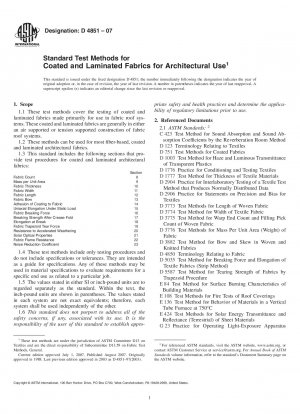ASTM D4851-07
Standard Test Methods for Coated and Laminated Fabrics for Architectural Use
- Standard No.
- ASTM D4851-07
- Release Date
- 2007
- Published By
- American Society for Testing and Materials (ASTM)
- Status
- Replace By
- ASTM D4851-07(2011)
- Latest
- ASTM D4851-07(2019)e1
- Scope
The procedures in this standard can be used for acceptance testing of commercial shipments of coated and laminated fabrics for architectural use since these test methods have been used extensively in the trade for acceptance testing. Caution is advised, however, when testing adhesion of coating to fabric and breaking strength after crease fold because between laboratory precision is known to be poor (see 24.2). For these cases, comparative tests conducted, as directed in 5.1.1, may be advisable.
5.1.1 In cases of a dispute arising from differences in reported test results when using Test Methods D 4851 for acceptance testing of commercial shipments, the purchaser and the supplier should conduct comparative tests to determine if there is a statistical bias between their laboratories. Competent statistical assistance is recommended for the investigation of bias. As a minimum, the two parties should take a group of test specimens which are as homogeneous as possible and from a lot of material of the type in question. The test specimens should then be randomly assigned in equal numbers to each laboratory for testing. The average results from the two laboratories should be compared using appropriate statistical analysis for unpaired data and an acceptable probability level chosen by the two parties before the testing is begun. If a bias is found, either its cause must be found and corrected or the purchaser and the supplier must agree to interpret future test results with consideration of the known bias.
The uses and significance of specific properties are discussed in the appropriate sections of specific test methods.
1.1 These test methods cover the testing of coated and laminated fabrics made primarily for use in fabric roof systems. These coated and laminated fabrics are generally in either an air supported or tension supported construction of fabric roof systems.
1.2 These methods can be used for most fiber-based, coated and laminated architectural fabrics.
1.3 This standard includes the following sections that provide test procedures for coated and laminated architectural fabrics:
1.4 These test methods include only testing procedures and do not include specifications or tolerances. They are intended as a guide for specifications. Any of these methods may be used in material specifications to evaluate requirements for a specific end use as related to a particular job.
1.5 The values stated in either SI or inch-pound units are to regarded separately as the standard. Within the text, the inch-pound units are shown in parentheses. The values stated in each system are not exact equivalents; therefore, each system shall be used independently of the other.
This standard does not purport to address all of the safety concerns, if any, associated with its use. It is the responsibility of the user of this standard to establish appropriate safety and health practices and determine the applicability of regulatory limitations prior to use.
ASTM D4851-07 Referenced Document
- ASTM C423 Standard Test Method for Sound Absorption and Sound Absorption Coefficients by the Reverberation Room Method
- ASTM D1003 Standard Test Method for Haze and Luminous Transmittance of Transparent Plastics
- ASTM D123 Standard Terminology Relating to Textiles
- ASTM D1776 Standard Practice for Conditioning and Testing Textiles
- ASTM D1777 Standard Test Method for Thickness of Textile Materials
- ASTM D2904 Standard Practice for Interlaboratory Testing of a Textile Test Method that Produces Normally Distributed Data
- ASTM D2906 Standard Practice for Statements on Precision and Bias for Textiles
- ASTM D3773 Standard Test Methods for Length of Woven Fabric
- ASTM D3774 Standard Test Method for Width of Textile Fabric
- ASTM D3775 Standard Test Method for Fabric Count of Woven Fabric
- ASTM D3776 Standard Test Methods for Mass Per Unit Area (Weight) of Fabric
- ASTM D3882 Standard Test Method for Bow and Skew in Woven and Knitted Fabrics
- ASTM D4850 Standard Terminology Relating to Fabrics and Fabric Test Methods
- ASTM D5035 Standard Test Method for Breaking Force and Elongation of Textile Fabrics (Strip Method)
- ASTM D5587 Standard Test Method for Tearing Strength of Fabrics by Trapezoid Procedure
- ASTM D751 Standard Test Methods for Coated Fabrics
- ASTM E108 Standard Methods of Fire Tests Of Roof Coverings
- ASTM E136 Standard Test Method for Behavior of Materials in a Vertical Tube Furnace at 750oC
- ASTM E424 Standard Test Methods for Solar Energy Transmittance and Reflectance (Terrestrial) of Sheet Materials
- ASTM E84 Standard Test Method for Surface Burning Characteristics of Building Materials
- ASTM G23 Practice for Operating Light-Exposure Apparatus (Carbon-Arc Type) With and Without Water for Exposure of Nonmetallic Materials
- ASTM G26 Practice for Operating Light-Exposure Apparatus (Xenon-Arc Type) With and Without Water for Exposure of Nonmetallic Materials (Withdrawn 2000)
- ASTM G53 Practice for Operating Light- and Water-Exposure Apparatus (Fluorescent UV-Condensation Type) for Exposure of Nonmetallic Materials
ASTM D4851-07 history
- 2015 ASTM D4851-07(2019)e1 Standard Test Methods for Coated and Laminated Fabrics for Architectural Use
- 2007 ASTM D4851-07(2015) Standard Test Methods for Coated and Laminated Fabrics for Architectural Use
- 2011 ASTM D4851-07(2011) Standard Test Methods for Coated and Laminated Fabrics for Architectural Use
- 2007 ASTM D4851-07 Standard Test Methods for Coated and Laminated Fabrics for Architectural Use
- 1997 ASTM D4851-97(2003) Standard Test Methods for Coated and Laminated Fabrics for Architectural Use
- 1997 ASTM D4851-97 Standard Test Methods for Coated and Laminated Fabrics for Architectural Use
